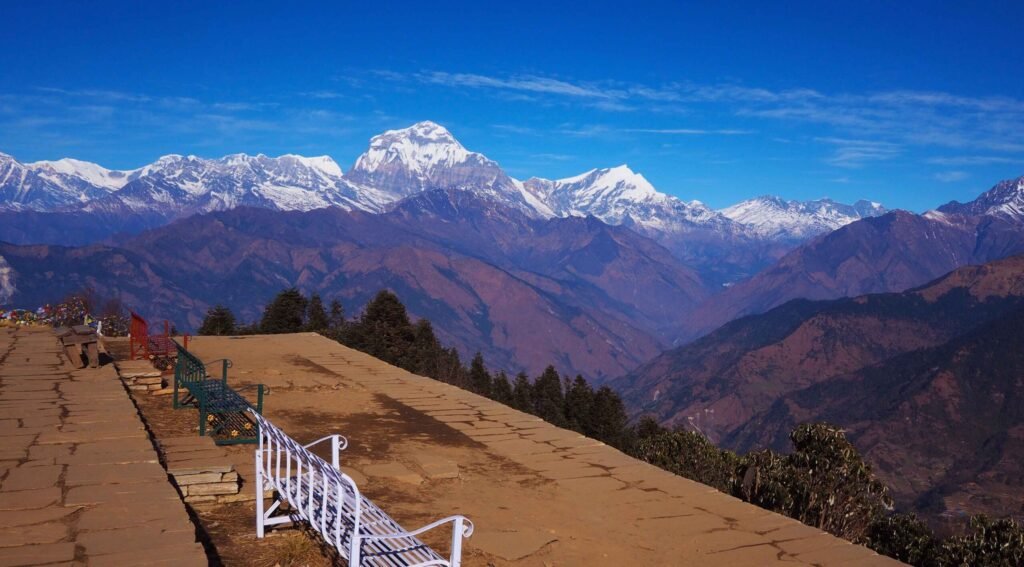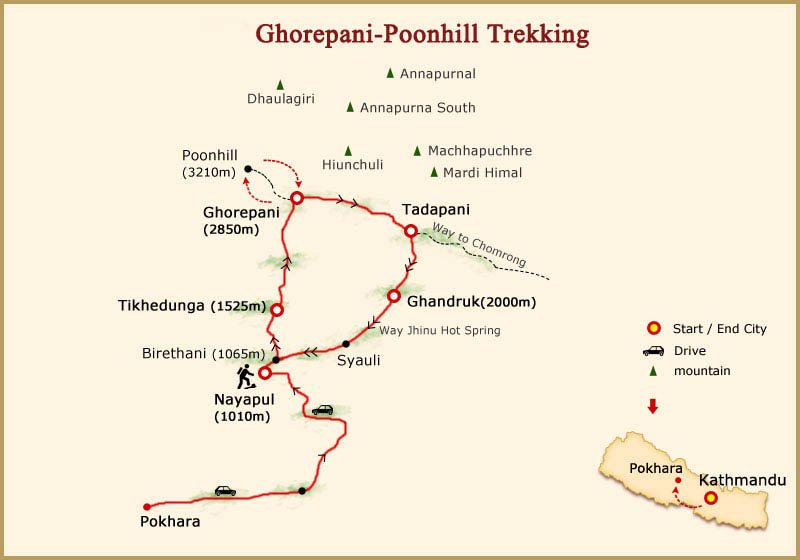Poon Hill Trek
Introduction: Nepal, renowned for its majestic Himalayan landscapes, beckons trekkers from around the globe with its plethora of scenic wonders. Among these, the Poon Hill Trek stands as a gem, offering a captivating journey through the Annapurna region. This trek, known for its breathtaking views of the Annapurna and Dhaulagiri mountain ranges, unfolds a rich tapestry of experiences that blend nature’s grandeur with cultural immersion. In this blog post, we embark on a virtual exploration of the Poon Hill Trek, unveiling its highlights, cultural treasures, challenges, and the allure that makes it a must-visit destination.
Geography and Highlights:
Nestled in the Annapurna region, the Poon Hill Trek is a short yet rewarding adventure that typically spans around 5 to 7 days. The trek commences from Nayapul, winding through lush rhododendron forests, terraced fields, and traditional Gurung and Magar villages. The ultimate destination, Poon Hill, offers an iconic vantage point at 3,210 meters, providing panoramic views of the Annapurna and Dhaulagiri mountain ranges during sunrise.
One of the trek’s key highlights is the spectacular sunrise view from Poon Hill. As the first rays of sunlight kiss the snow-capped peaks, a mesmerizing play of colors unfolds, transforming the mountains into a canvas of golden hues. The panoramic vista includes Annapurna South, Annapurna I, Dhaulagiri, and the sacred Machapuchare, creating a breathtaking panorama that lingers in the memory of every trekker.
Cultural Immersion:
Beyond its natural wonders, the Poon Hill Trek offers a unique opportunity for cultural immersion. Trekking through traditional Gurung and Magar villages like Ghandruk and Ghorepani allows trekkers to witness the warmth and hospitality of the locals. The traditional architecture, terraced fields, and vibrant prayer flags contribute to the cultural richness of the journey.
Ghandruk, with its stone-paved streets and traditional houses, is a cultural hub along the trek. The Gurung Museum provides insights into the community’s history and customs. Trekkers often have the chance to participate in local festivals, observe traditional dances, and savor authentic Nepali cuisine, fostering a deep connection with the cultural heritage of the region.
Challenges and Preparations:
The Poon Hill Trek is considered a moderate trek, making it accessible to a wide range of trekkers, including beginners. Nevertheless, it is essential to be adequately prepared for the journey. The trek involves ascending and descending trails, and a reasonable level of fitness is recommended. Training for stamina and endurance can enhance the overall trekking experience.
As with any trek in the Himalayas, proper acclimatization is crucial. The gradual ascent and the inclusion of rest days in the itinerary help the body adjust to the increasing altitude, minimizing the risk of altitude-related issues. Ensuring that you have suitable trekking gear, including sturdy boots, layered clothing, and a good backpack, contributes to a comfortable and enjoyable trek.
Best Time to Trek:
The Poon Hill Trek is enchanting throughout the year, but the optimal times to undertake the journey are during the spring (March to May) and autumn (September to November) seasons. During these periods, the weather is generally stable, with clear skies providing unobstructed views of the mountains. The spring season brings blooming rhododendrons, adding a burst of color to the trek, while autumn offers crisp, cool days for a pleasant trekking experience.
Conclusion – Poon Hill Trek :
The Poon Hill Trek, with its harmonious blend of natural beauty and cultural immersion, is a testament to Nepal’s allure as a trekking paradise. From the charming villages and terraced fields to the awe-inspiring sunrise views at Poon Hill, every step of the journey unfolds a new facet of the Himalayan landscape. Whether you’re a seasoned trekker or a novice adventurer, the Poon Hill Trek promises an unforgettable experience, leaving indelible memories of Nepal’s majestic mountains and warm-hearted communities. So, lace up your boots, breathe in the mountain air, and let the Poon Hill Trek weave its spellbinding magic on your soul.

Poon Hill
Frequently Asked Questions (FAQs) – Poon Hill Trek
1. What is the Poon Hill Trek, and where is it located?
The Poon Hill Trek is a popular trekking route in the Annapurna region of Nepal. It typically starts from Nayapul and passes through picturesque villages like Ghandruk and Ghorepani, culminating in the panoramic viewpoint of Poon Hill at 3,210 meters.
2. How long does the Poon Hill Trek take?
The duration of the Poon Hill Trek is usually around 5 to 7 days, depending on the specific itinerary and trekking pace. The trek can be customized to accommodate various preferences and time constraints.
3. What are the highlights of the Poon Hill Trek?
The key highlights of the trek include the stunning sunrise view from Poon Hill, offering panoramic vistas of the Annapurna and Dhaulagiri mountain ranges. Additionally, trekking through traditional Gurung and Magar villages, exploring cultural sites, and experiencing the warmth of the local hospitality are significant highlights.
4. Is the Poon Hill Trek suitable for beginners?
Yes, the Poon Hill Trek is considered a moderate trek, making it accessible to beginners and trekkers with varying levels of experience. The well-maintained trails and gradual ascents provide a manageable challenge for those new to trekking.
5. What is the best time to undertake the Poon Hill Trek?
The optimal times for the Poon Hill Trek are during the spring (March to May) and autumn (September to November) seasons. These periods offer stable weather conditions, clear skies, and pleasant temperatures, providing an ideal trekking environment.
6. Are permits required for the Poon Hill Trek?
Yes, trekkers need to obtain the Annapurna Conservation Area Permit (ACAP) to embark on the Poon Hill Trek. It is advisable to check with local authorities and ensure all necessary permits are acquired before starting the trek.
7. What level of fitness is required for the Poon Hill Trek?
The Poon Hill Trek is considered moderate in terms of difficulty. While prior trekking experience is beneficial, individuals with a reasonable level of fitness can undertake and enjoy the trek. Training for stamina and endurance can enhance the overall trekking experience.
8. What kind of accommodation can I expect during the Poon Hill Trek?
Teahouses or guesthouses are the primary accommodation options along the Poon Hill Trek. These lodges provide basic amenities, including meals, a place to rest, and the chance to interact with fellow trekkers. The facilities are simple, with shared bathrooms in most cases.
9. Are there alternatives or side trips along the Poon Hill Trek?
Yes, there are alternatives and side trips available to enhance the trekking experience. Extensions to other villages, such as Tadapani and Landruk, can be incorporated into the itinerary. Additionally, exploring nearby attractions like the hot springs in Jhinu Danda offers an added dimension to the journey.
10. Is it necessary to hire a guide or porter for the Poon Hill Trek?
While it’s not mandatory, hiring a guide is recommended for a more enriching experience. Guides provide insights into the local culture, navigate the trails, and ensure a smoother journey. Hiring a porter can also lighten the load for trekkers, making the trek more comfortable.
Before embarking on the Poon Hill Trek, it’s advisable to research, plan thoroughly, and be well-prepared for the trekking adventure.


